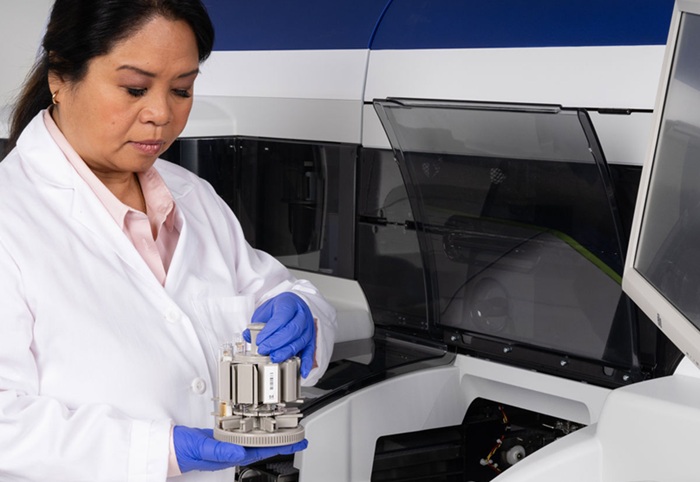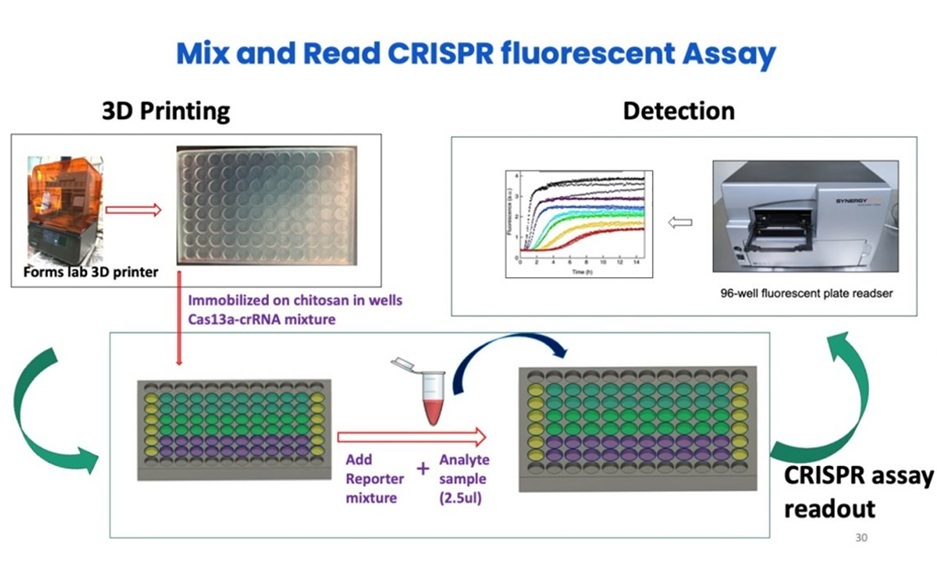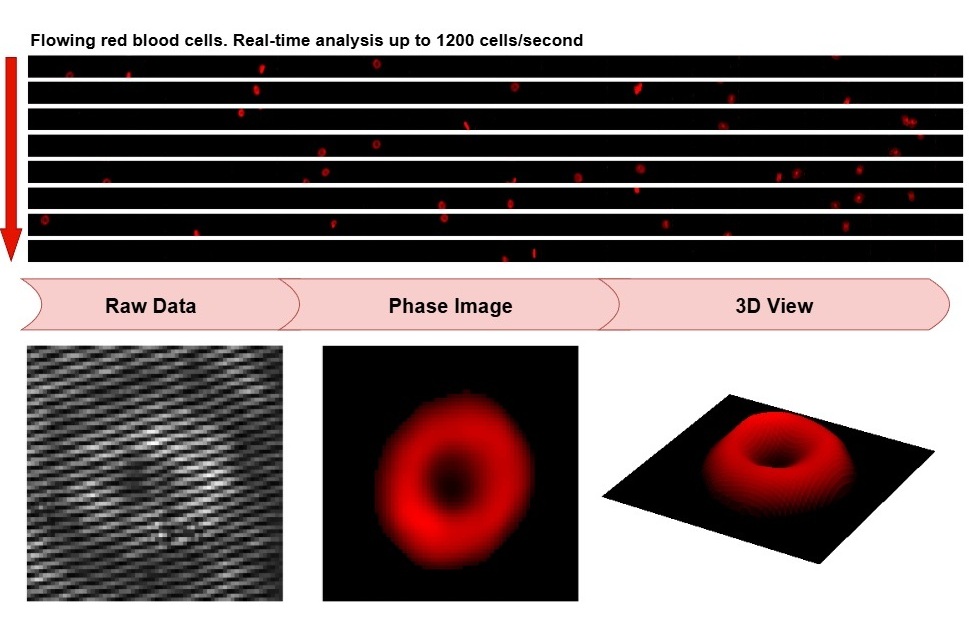CD8 T-Cell–Predominant Lymphocytic Esophagitis Associated with GERD
|
By LabMedica International staff writers Posted on 05 Oct 2021 |
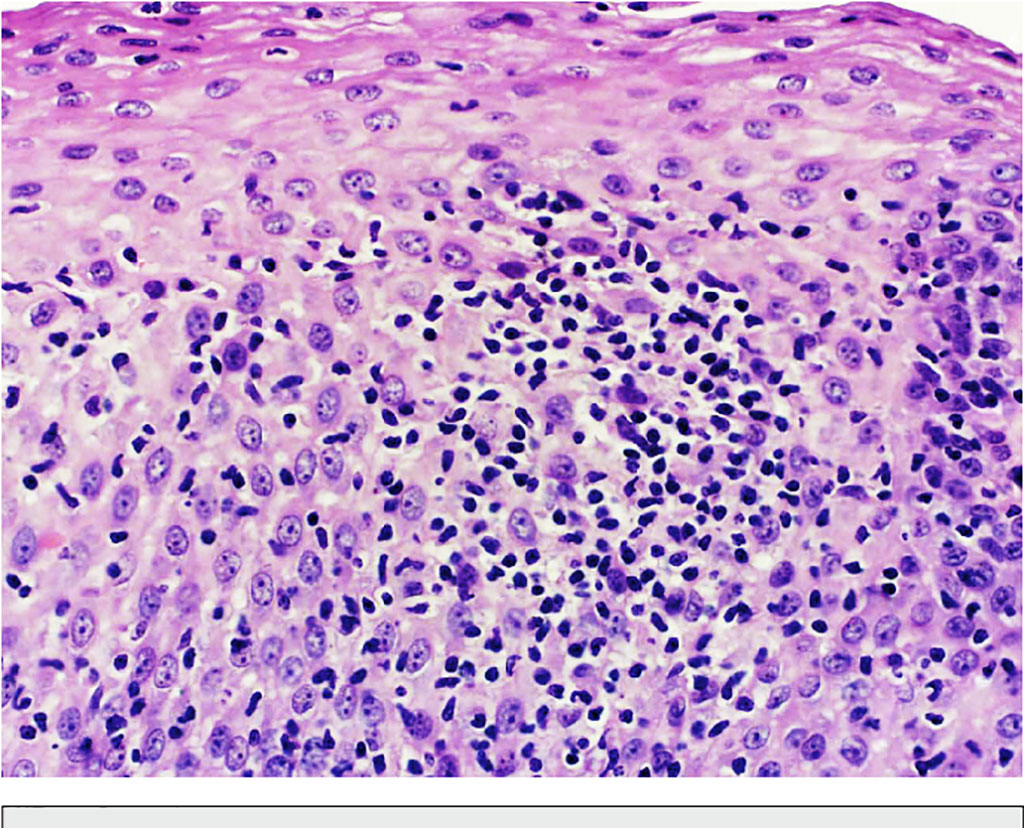
Image: Histopathology photomicrograph of lymphocytic esophagitis: Esophageal mucosa showing peripapillary intraepithelial lymphocytosis with basal zone hyperplasia and intercellular edema. No significant population of eosinophils or neutrophils is identified (Photo courtesy of Yusuf Kasirye, MD, et al)
In patients with reflux esophagitis (RE), increased lymphocytes are often part of a mixed inflammatory infiltrate that also includes eosinophils and/or neutrophils. Less frequently, lymphocytes are the only type of inflammatory cells associated with gastroesophageal reflux disease (GERD).
One such pattern is lymphocytic esophagitis (LyE), which is characterized by an elevated number of peripapillary lymphocytes and absent or rare intraepithelial granulocytes. This pattern has been reported in approximately 5% of patients with endoscopic esophagitis and 7% of patients with Barrett esophagus.
Clinical Scientists at the Dartmouth-Hitchcock Medical Center (Lebanon, NH, USA) conducted an observational retrospective study and identified 161 patients seen at their institution from 1998 to 2014 who were diagnosed with GERD, had normal esophageal motility, and available esophageal biopsies. For all patients meeting inclusion criteria, the team obtained demographic data as well as information pertaining to clinical diagnosis, past medical history, and endoscopic, imaging, manometry, and, where available, pH-metry findings from the files and electronic medical records.
Biopsy specimens were fixed in 10% formalin, paraffin-embedded, and stained with hematoxylin-eosin. A single peripapillary lymphoid infiltrate was sufficient for the diagnosis of LyE. The cutoffs for a normal number of intraepithelial lymphocytes evaluated in hematoxylin-eosin–stained slides at different levels, such as gastroesophageal junction, distal esophagus, and midesophagus were 62, 46, and 41 lymphocytes per high-power field, respectively. Cells were counted in one mostly affected high-power field using an Olympus BX 41 microscope (Olympus, Center Valley, PA, USA). Routine CD4 and CD8 immunohistochemistry was performed using Bond Polymer Refine Detection staining reagents and Bond III autostainer (Leica Microsystems, Buffalo Grove, IL, USA).
The scientists found increased intraepithelial lymphocytes in 13.7% of patients with GERD. Two major patterns and one minor pattern of lymphocytic inflammation were observed as follows: (1) LyE (in 6.8% [11 of 161] of patients and typically focal), (2) dispersed lymphocytes in an area of reflux esophagitis (in 5.6% [9 of 161] and typically diffuse), and (3) peripapillary lymphocytes in an area of reflux esophagitis (in 1.2% [2 of 161]). CD8 T cells significantly outnumbered CD4 T cells in 91% of patients with lymphocytic esophagitis and 100% of patients with dispersed lymphocytes (9 of 9) or peripapillary lymphocytes (2 of 2) in the area of reflux esophagitis.
The authors concluded that their findings suggest that LyE is one of the major patterns of lymphocytic inflammation in GERD. CD8 T-cell–predominant immunophenotype may be useful as a marker of GERD in the differential diagnosis of LyE. The study was published in the September 2021 issue of the journal Archives of Pathology and Laboratory Medicine.
Related Links:
Dartmouth-Hitchcock Medical Center
Olympus
Leica Microsystems
One such pattern is lymphocytic esophagitis (LyE), which is characterized by an elevated number of peripapillary lymphocytes and absent or rare intraepithelial granulocytes. This pattern has been reported in approximately 5% of patients with endoscopic esophagitis and 7% of patients with Barrett esophagus.
Clinical Scientists at the Dartmouth-Hitchcock Medical Center (Lebanon, NH, USA) conducted an observational retrospective study and identified 161 patients seen at their institution from 1998 to 2014 who were diagnosed with GERD, had normal esophageal motility, and available esophageal biopsies. For all patients meeting inclusion criteria, the team obtained demographic data as well as information pertaining to clinical diagnosis, past medical history, and endoscopic, imaging, manometry, and, where available, pH-metry findings from the files and electronic medical records.
Biopsy specimens were fixed in 10% formalin, paraffin-embedded, and stained with hematoxylin-eosin. A single peripapillary lymphoid infiltrate was sufficient for the diagnosis of LyE. The cutoffs for a normal number of intraepithelial lymphocytes evaluated in hematoxylin-eosin–stained slides at different levels, such as gastroesophageal junction, distal esophagus, and midesophagus were 62, 46, and 41 lymphocytes per high-power field, respectively. Cells were counted in one mostly affected high-power field using an Olympus BX 41 microscope (Olympus, Center Valley, PA, USA). Routine CD4 and CD8 immunohistochemistry was performed using Bond Polymer Refine Detection staining reagents and Bond III autostainer (Leica Microsystems, Buffalo Grove, IL, USA).
The scientists found increased intraepithelial lymphocytes in 13.7% of patients with GERD. Two major patterns and one minor pattern of lymphocytic inflammation were observed as follows: (1) LyE (in 6.8% [11 of 161] of patients and typically focal), (2) dispersed lymphocytes in an area of reflux esophagitis (in 5.6% [9 of 161] and typically diffuse), and (3) peripapillary lymphocytes in an area of reflux esophagitis (in 1.2% [2 of 161]). CD8 T cells significantly outnumbered CD4 T cells in 91% of patients with lymphocytic esophagitis and 100% of patients with dispersed lymphocytes (9 of 9) or peripapillary lymphocytes (2 of 2) in the area of reflux esophagitis.
The authors concluded that their findings suggest that LyE is one of the major patterns of lymphocytic inflammation in GERD. CD8 T-cell–predominant immunophenotype may be useful as a marker of GERD in the differential diagnosis of LyE. The study was published in the September 2021 issue of the journal Archives of Pathology and Laboratory Medicine.
Related Links:
Dartmouth-Hitchcock Medical Center
Olympus
Leica Microsystems
Latest Pathology News
- Highly Sensitive Imaging Technique Detects Myelin Damage
- 3D Genome Mapping Tool to Improve Diagnosis and Treatment of Genetic Diseases
- New Molecular Analysis Tool to Improve Disease Diagnosis
- Tears Offer Noninvasive Alternative for Diagnosing Neurodegenerative Diseases
- AI-Powered Method Combines Blood Data to Accurately Measure Biological Age
- AI Tool Detects Cancer in Blood Samples In 10 Minutes
- AI Pathology Analysis System Delivers Comprehensive Cancer Diagnosis
- AI Improves Cervical Cancer Screening in Low-Resource Settings
- New Multi-Omics Tool Illuminates Cancer Progression
- New Technique Detects Genetic Mutations in Brain Tumors During Surgery within 25 Minutes
- New Imaging Tech to Improve Diagnosis and Treatment of Skin Cancers
- Serially Testing Brain Tumor Samples Reveals Treatment Response in Glioblastoma Patients
- High-Accuracy Tumor Detection Method Offers Real-Time Surgical Guidance
- AI Tool Detects Hidden Warning Signs of Disease Inside Single Cells
- Automated Tool Detects Early Warning Signs of Breast Cancer
- New Software Tool Improves Analysis of Complex Spatial Data from Tissues
Channels
Clinical Chemistry
view channel
VOCs Show Promise for Early Multi-Cancer Detection
Early cancer detection is critical to improving survival rates, but most current screening methods focus on individual cancer types and often involve invasive procedures. This makes it difficult to identify... Read more
Portable Raman Spectroscopy Offers Cost-Effective Kidney Disease Diagnosis at POC
Kidney disease is typically diagnosed through blood or urine tests, often when patients present with symptoms such as blood in urine, shortness of breath, or weight loss. While these tests are common,... Read moreMolecular Diagnostics
view channel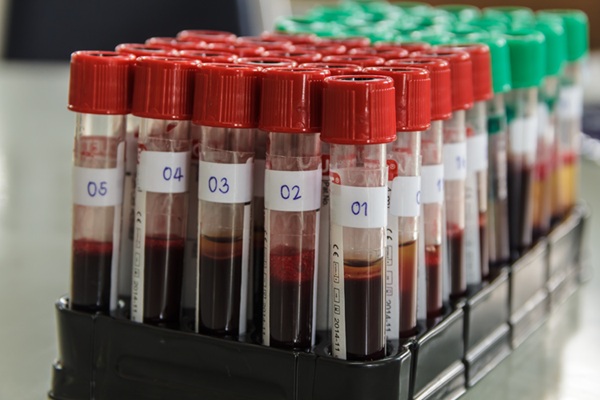
Dual Blood Biomarkers Improve ALS Diagnostic Accuracy
Diagnosing amyotrophic lateral sclerosis (ALS) remains difficult even with advanced imaging and genetic tools, especially when clinicians must distinguish it from other neurodegenerative conditions that... Read more
Automated Test Distinguishes Dengue from Acute Fever-Causing Illnesses In 18 Minutes
Dengue fever remains the most common mosquito-borne viral infection worldwide, posing a major public health challenge as global cases continue to surge. In 2024 alone, more than 14.6 million infections... Read moreHematology
view channel
ADLM’s New Coagulation Testing Guidance to Improve Care for Patients on Blood Thinners
Direct oral anticoagulants (DOACs) are one of the most common types of blood thinners. Patients take them to prevent a host of complications that could arise from blood clotting, including stroke, deep... Read more
Viscoelastic Testing Could Improve Treatment of Maternal Hemorrhage
Postpartum hemorrhage, severe bleeding after childbirth, remains one of the leading causes of maternal mortality worldwide, yet many of these deaths are preventable. Standard care can be hindered by delays... Read more
Pioneering Model Measures Radiation Exposure in Blood for Precise Cancer Treatments
Scientists have long focused on protecting organs near tumors during radiotherapy, but blood — a vital, circulating tissue — has largely been excluded from dose calculations. Each blood cell passing through... Read moreImmunology
view channel
Chip Captures Cancer Cells from Blood to Help Select Right Breast Cancer Treatment
Ductal carcinoma in situ (DCIS) accounts for about a quarter of all breast cancer cases and generally carries a good prognosis. This non-invasive form of the disease may or may not become life-threatening.... Read more
Blood-Based Liquid Biopsy Model Analyzes Immunotherapy Effectiveness
Immunotherapy has revolutionized cancer care by harnessing the immune system to fight tumors, yet predicting who will benefit remains a major challenge. Many patients undergo costly and taxing treatment... Read moreMicrobiology
view channel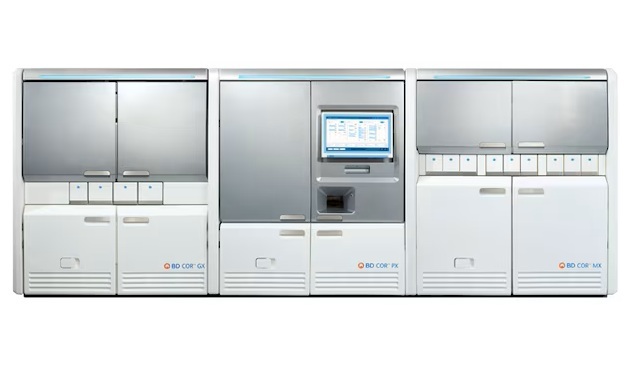
High-Throughput Enteric Panels Detect Multiple GI Bacterial Infections from Single Stool Swab Sample
Gastrointestinal (GI) infections are among the most common causes of illness worldwide, leading to over 1.7 million deaths annually and placing a heavy burden on healthcare systems. Conventional diagnostic... Read more
Fast Noninvasive Bedside Test Uses Sugar Fingerprint to Detect Fungal Infections
Candida bloodstream infections are a growing global health threat, causing an estimated 6 million cases and 3.8 million deaths annually. Hospitals are particularly vulnerable, as weakened patients after... Read moreTechnology
view channel
Portable Biosensor Diagnoses Psychiatric Disorders Using Saliva Samples
Early diagnosis of psychiatric disorders such as depression, schizophrenia, and bipolar disorder remains one of medicine’s most pressing challenges. Current diagnostic methods rely heavily on clinical... Read more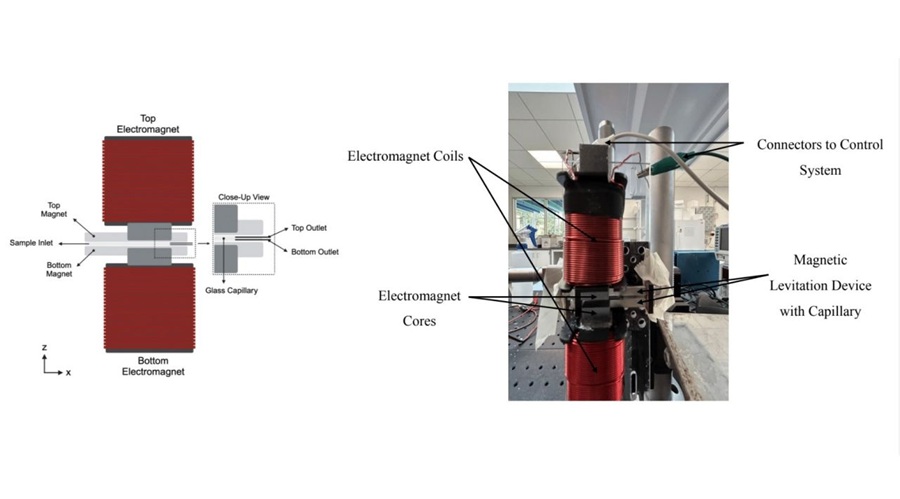
Cell-Sorting Device Uses Electromagnetic Levitation to Precisely Direct Cell Movement
Sorting different cell types—such as cancerous versus healthy or live versus dead cells—is a critical task in biology and medicine. However, conventional methods often require labeling, chemical exposure,... Read moreIndustry
view channel
Co-Diagnostics Forms New Business Unit to Develop AI-Powered Diagnostics
Co-Diagnostics, Inc. (Salt Lake City, UT, USA) has formed a new artificial intelligence (AI) business unit to integrate the company's existing and planned AI applications into its Co-Dx Primer Ai platform.... Read more













